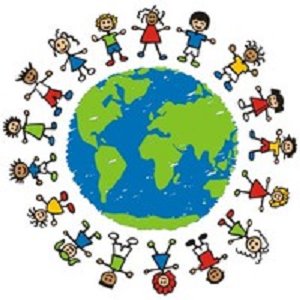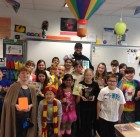Viewing: community
October 2, 2014
Our Social Contract (Classroom Community – Part 2)
In a recent post, I wrote about how we work to build a cohesive classroom community in our room. In this post, I will share our classroom’s social contract with you, as well as explain how we help one another to live up to the contract. In early August, I attended the Capturing Kids’  Hearts workshop (which I described in the previous post). One substantial focus of the workshop was the concept of using a social contract. This document outlines how students want to be treated by teachers, how teachers want to be treated by students, how students want to be treated by one another, and how we all want to be treated by either during a conflict. After brainstorming descriptors over the first few weeks of school, groups of students shared out their ideas, and we made a master list as a class. As descriptors were repeated, we added checks to the list. We didn’t distinguish between the four categories I listed because it became apparent (by design) that the descriptions we found were applicable in all instances.
Hearts workshop (which I described in the previous post). One substantial focus of the workshop was the concept of using a social contract. This document outlines how students want to be treated by teachers, how teachers want to be treated by students, how students want to be treated by one another, and how we all want to be treated by either during a conflict. After brainstorming descriptors over the first few weeks of school, groups of students shared out their ideas, and we made a master list as a class. As descriptors were repeated, we added checks to the list. We didn’t distinguish between the four categories I listed because it became apparent (by design) that the descriptions we found were applicable in all instances.
I must tell you how very impressed I was by the depth of thought that the kids put into their brainstorming. As you can see from our social contract, some ideas were common themes in our discussion: kindness, fairness, honesty, respect, friendliness, safety, candor, patience, and more! All students chose to sign the contract as their agreement to try to live up to the document. (This wasn’t mandatory – everyone CHOSE to get “on board” with the contract.)
One reminder that I give to the class is that we will not be perfect in following the contract. There are days when we all make mistakes, and what’s important is that we work to make the best choices we possibly can, rather than being perfect. The word “accountable” only came up twice, but I think we’ve found that it’s become one of the most important words in the contract as it’s been put to use.
When students (or I, for that matter) don’t live up to the social contract, we use the document to help us to problem solve. Rather than discussions taking the tone of “You are breaking the rules. You may not do that.” or “You’re not allowed to take things of ___’s desk.” we can instead refer back to the social contract. Conversations have a more positive tone, such as: “Billy, we all agreed to follow the social contract so that everyone can learn in a comfortable, safe environment. We agreed to treat each other kindly. You signed this contract, and we all need to work hard to be successful. When you _________, do you think it helped _______ to feel respected? … How could we help ____ to feel respected?” Notice how I use words from the contract in that example – it’s a document that the kids generated, so they have a great sense of ownership over it. They want to live up to the social contract.
The reality, of course, is that we won’t always be successful. Part of building a classroom community involves empowering students to help one another to be successful. When they see another student not making good choices, they’re encouraged to use a gesture – a wiggling fist, with the thumb extended upward – to help their peer to make a better choice. This isn’t a way of tattling on a classmate to me, indeed, I tell the kids that this works best when I have no idea that it’s happening. The best metaphor is a baseball connection. When a player is having a rough time at a game and gets in the umpire’s face to scream, his fellow players run up and often hold him back and bring him back to the dugout. Why? Because they want to keep their teammate in the game, working to help the team to win. It’s the same idea in our class – using the thumb gesture is intended to help a peer to make better choices so that they can stay “in the game” and keep our whole class successful.
When poor choices continue, we do need to rely on classroom consequences. But like the social contract, these were student-generated. We talked about the difference between punishments and consequences, and that punishments are designed to be punitive, while consequences are simply the effects that follow a choice we make. When you look at our list of consequences, you’ll see that many of the kids’ ideas were more like punishments (listed in purple) rather than consequences (yellow highlighting). I believe in logical consequences – making sure that the consequence is connected to the choices that the student made. Items in green can happen anytime, but you’ll see that students will be given a warning and then asked to take a time out before having to visit the office.
In the next post (the third and final in the series), I’ll tell you a bit about some of the ways I help students to motivate themselves to make the best choices they can! Stay tuned!
Posted in Class Updates|By Jon Moss
September 16, 2014
Building a Classroom Community (Part 1)
 Were you expecting a post about academic work in class? Fear not, that will come soon! But before our class could experience academic success, we had to find success with establishing a classroom community. I briefly addressed this at Curriculum Night, but I’d like to tell you a bit more about my philosophies and how these look within our classroom.
Were you expecting a post about academic work in class? Fear not, that will come soon! But before our class could experience academic success, we had to find success with establishing a classroom community. I briefly addressed this at Curriculum Night, but I’d like to tell you a bit more about my philosophies and how these look within our classroom.
First, notice that I said “our” classroom. It’s not my classroom. It’s the kids’ room. And, yes, mine too. But it’s your room too. We all have a vested interest in what happens in the room, we all want EVERYONE to be successful in the class, and since the learning experience continues when kids go home to work on their homework, you, as parents, definitely count as part of our class.
Second, from the start of school, we look at what makes us whole. We’re a class of 24 students and one teacher, which makes us a community of 25 learners. I learn from the kids just as they learn from me (and from each other, too!) We talk regularly about how we need everyone here in class in order to be a whole group, and that everyone plays an important part in making us a CLASS, not just a group of people in a room together for 180 days.
At this point, I’m sure many of you are jokingly wondering when I will start singing Kumbaya with the kids. Building a close classroom community has always been important to me, because I know that when kids feel safe and comfortable and valued in class, they are better able to take academic risks, ask for help, make productive mistakes, and most of all, LEARN. Over the years, I have implemented the Responsive Classroom approach, which highlights a positive start to the day with Morning Meeting, building a classroom community, and logical consequences.
This summer, I had the wonderful opportunity to become trained in Capturing Kids’ Hearts, which is a separate approach that works in cooperation with Responsive Classroom. Let me first say that Capturing Kids’ Hearts SOUNDS really cheesy and hokey based on its name. I realize this, but I hope you’ll look past that. CKH focuses on helping teachers to reach each student and to show students that we genuinely care about them, believe in them, and are willing to help them to be as successful as they possibly can be. This starts with morning arrival. I try to greet each student, personally, as they arrive in the morning. Besides being courteous, it also lets me quickly see how everyone’s doing. If I can quickly spot a brewing problem, I can work to help address whatever is bothering the student and hopefully get the day started off on a good note. Even in 12 days, I’ve seen what a big difference this makes! It’s great to see kids now approaching me in the morning, hands extended, waiting to greet ME, rather than waiting for me to come to them. Also, new to Morning Meeting this year is Good News, which allows students to share (you guessed it) good news with the class. Good News can be big (such as “We’re getting a new puppy!” or “I won my first baseball game!”), but I really want to remind kids that Good News can be “small stuff” that seems less significant, such as “I woke up this morning without my mom having to nag me!” or “I was running late this morning, but I made it to school on time!” (That was my Good News last week.) This also helps the day to start on a good note, but it also helps to grow the sense of community in class (as kids genuinely share in each other’s excitement!)
This video will give you a brief overview of what Capturing Kids’ Hearts is, what it does, and why it’s a tremendous asset to teachers!
To be continued in an upcoming post!
Posted in Class Updates|By Jon Moss
March 22, 2014

One School, One Book
This week, our school is finishing our first (annual, hopefully) One School, One Book activity. For the past few weeks, students throughout PGS have jointly read the first book of the According to Humphrey series. Each week, students read through a few chapters at home with their families, and on Fridays, as a whole school, we continued to read the book together. This particular book has been a great choice because it’s an easy enough book to be appropriate to read with kindergarteners, but it also has terrific opportunities for inferences and connections, making it a good fit for older students. Two weeks ago, PGS students dressed up as their favorite book characters, which was a fun way to celebrate many of our favorite books!
Posted in Class Updates|By Jon Moss
